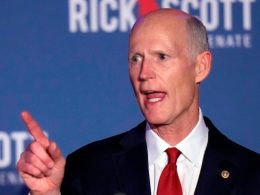With jobs data this week suggesting the US economy is still robust, attention next week will turn to the Federal Reserve’s other big preoccupation: whether price pressures are easing.
January’s consumer price index data is due on Wednesday and is expected to show a slight slowing of the rate of price rises, though that is unlikely to be enough to rush the central bank into another interest rate cut.
The closely watched core inflation measure, which strips out volatile food and energy prices, is expected to come in at 0.3 per cent month on month, for a 3.1 per cent year on year rate, according to economists polled by Reuters, down from 3.2 per cent in December. The headline rate is forecast to remain at 2.9 per cent.
Last month the Fed left rates on hold and signalled it was in no hurry to ease further unless the data supported such a move.
Futures markets imply investors are pricing in an 80 per cent chance of a quarter-point rate cut by the central bank’s July meeting, and are split on the chances of a further one by year-end.
Wednesday’s data will be examined for any signs of the wage inflation seen in this week’s jobs figures, where wages rose 0.5 per cent month on month, compared with a forecast for 0.3 per cent. Unemployment also slipped to 4 per cent, implying a tighter labour market that could stoke price pressures.
“The Fed clearly will not like what happened with the unemployment rate and the wage number,” said David Rosenberg of Rosenberg Research, although he added that the data still supports the central bank remaining on hold for now. Jennifer Hughes
Has the UK economy returned to growth?
UK economic growth data to be published by the Office for National Statistics on Thursday is expected to deliver a fresh blow to chancellor Rachel Reeves.
Economists polled by Reuters expect the economy to have contracted by 0.1 per cent over for the final quarter of 2024, following a period of no growth in the previous three months. That would be bad news for the government’s mission to boost growth and could add to fears over possible stagflation.
The forecast is in line with the expectations of the Bank of England, which on Thursday said the decline in part reflected “a broad-based downturn in business confidence”. The economy has been broadly stagnant since March, with businesses warning of job cuts in recent months following the increase in employers’ national insurance contributions announced in the October Budget.
A larger than expected economic contraction in the final quarter or downward revisions to previous data could bolster markets’ expectations for interest rate cuts this year. Investors currently anticipate two further rate reductions in 2025, following the BoE’s decision to lower borrowing costs to 4.5 per cent this week, with some chance of a third.
The BoE now expects only meagre growth of 0.1 per cent in the first quarter of this year, a sharp downgrade from the 0.4 per cent expansion it expected as recently as November. It also downgraded its growth forecast for the whole of 2025 to 0.75 per cent, from the 1.5 per cent expected in November.
Ellie Henderson, economist at investment bank Investec, also expects “only modest growth” for much of the first half of this year, but added that “all is not lost”.
With wages rising faster than inflation and high levels of household savings, “consumers have the means to unleash more consumption, if they so wish”, Henderson said. Valentina Romei
Could the Swiss National Bank take interest rates below zero this year?
Swiss inflation figures due on Thursday could prove a crucial data point in helping determine whether the country heads back into negative interest rate territory this year.
The consumer price index declined 0.1 per cent in December compared with the previous month, leaving annual inflation at 0.6 per cent. Analysts will look to the January figure for clues as to how far the Swiss National Bank will cut rates from their current level of 0.5 per cent, with Oxford Economics expecting a 0.2 month on month fall in the index last month, leaving annual inflation at 0.3 per cent.
Switzerland’s “benign” inflation backdrop in combination with its lacklustre pace of growth could mean “there is a possibility” that interest rates turn negative once again, as they were for a prolonged period until 2022, said Rabobank analysts.
Switzerland avoided the worst of the inflation that swept across Europe in recent years, and was the first big western central bank to cut rates in March last year.
However, it announced a 0.5 percentage point cut in December, its biggest reduction in almost a decade, in response to weaker than expected inflation and growing uncertainty about the global economy.
Markets are currently pricing in an 80 per cent chance that the SNB will cut borrowing costs to 0.25 per cent in March, with a roughly 40 per cent likelihood that rates will reach zero in June.
Tomas Dvorak, an economist at Oxford Economics, expects inflation to hover between 0.3-0.5 per cent throughout the year, partly because the country’s service-heavy economy and non-EU member status may mean it escapes some of US President Donald Trump’s tariffs.
However, the central bank does not have much room to manoeuvre, he added. “It would take just another negative shock to curb demand to push it [interest rates] below zero . . . So both deflation and negative rates are on the table.” Mari Novik
Source link









